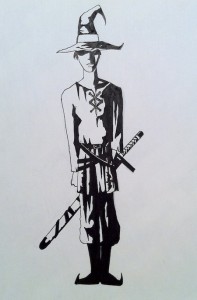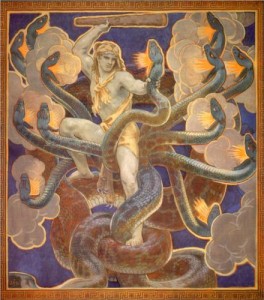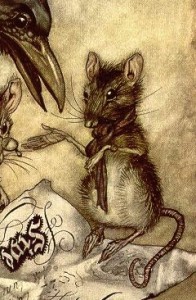
Black Mage (personal sketch)
The set of starting classes is relatively limited, despite the many classes sometimes available in console RPGs. I think Moldvay had it about right with 7 major options for PCs at the beginning of a campaign. In console games, other classes are often made available by the recruiting of new party members as the game progresses, so the complexity is introduced slowly. To allow for something similar, I’m also planning on including “unlockable” classes that must be discovered through play (I do this in my OD&D game too, so it’s not really novel, but seems extra-appropriate here).
Right now, the core classes are black mage, red mage, white mage, thief, warrior, and wushi (a martial artist). Summoner, dragoon/lancer, and mana engineer are all also prime contenders, though some of those may work better as “upgrade” classes, which will be provided to support progressions like black mage → black wizard or warrior → paladin, drive adventures after third level, and make new, specialized powers available (without adding more hit dice or numerical inflation, hopefully). I don’t see upgrade classes having levels, but rather just adding one or two abilities to characters.
Thanks to Brock C. for mentioning spell medallions that must be affixed to hats, which was partially responsible for my spell crystals idea here. I’m still on the fence about whether to refer to “one mana spells” or “first level spells.” Intercept wording is a cut and paste and requires improvement. Red mage mana capacity may need to be tweaked for balance. When considering the various class abilities, remember that max level is 3.
Every class has two primary stats: HD (hit die) and AC (armor class). HD is a measure of combat skill and resilience. HP is determined at the beginning of each session by rolling 1 HD per level and adding CON (+CON to the total rolled, not to each die separately). The lower of hit die and weapon die is used for weapon damage. That is, hit die is a limiting factor on weapon damage. AC is fixed by class and does not depend on the armor worn.
Some examples. A third level warrior rolls 3d10 +CON for HP at the beginning of each adventure, and rolls up to 1d10 +STR for damage (depending on the weapon die). A black mage can wield a sword, but it’s damage die will still only be 1d6 (though other weapon properties may still apply).
| Class | HD | AC | Features |
|---|---|---|---|
| Mage, Black | d6 | 10 | black magic, 3 mana/level +INT |
| Mage, Red | d8 | 14 | black & white magic, 2 mana/level |
| Mage, White | d6 | 12 | white magic, 3 mana/level +WIS |
| Thief | d6 | 12 | surprise attack, improved basic skills, thief skills |
| Warrior | d10 | 16 | attack bonus, cleave, intercept |
| Wushi | d8 | 14 | counterattack, deadly fists, pummel |
Locked Classes
Some classes must be unlocked through play before they become available. Future versions of this game will include several locked classes.
Upgrade Classes
Characters may not gain any levels above 3, but once level 3 is reached in a base class, that class may be upgraded. Upgrade classes do not provide more HD, but do make new abilities available. For example, a warrior might become a paladin, and gain a limited ability to use white magic. Rules for upgrade classes will be provided in future versions of this game.
Mage
Mages use the energy of mana to cast spells. Each mage belongs to an order as well, which teaches a certain style of spell casting.
Spells
Magic uses special alchemically prepared, mana-infused crystals that contain spells. Mages can use a spell crystal directly to cast the contained spell, which destroys the crystal, or set the crystal in a focus, such as a wand or staff, which allows the spell to be cast multiple times. Focused spells require the mage to supply the necessary mana, whereas crystals may be consumed to cast a spell for free.
Mages begin with two spell crystals (each containing a one mana spell) and a wand with two slots. More spell crystals may be bought from mages in town or found during adventures, as can foci with more slots.
Mages acquire titles in their order as they increase in level. These titles are:
- Apprentice
- Journeyer
- Master
Black mage
Black mages study the powers of destruction and death. This does not necessarily make them evil, but they are widely feared. The symbol of the black mages is a pointed hat.
Black mages only know how to cast black magic and have 3 mana per level +INT. For example, a third level black mage with INT +2 has (3 x 3) +2 = 11 mana.
Red mage
The order of red mages prizes broad learning, and thus red mages are able to use both black and white magic. They also train for battle, and thus have greater combat resilience and skill with weapons. However, this versatility comes with drawbacks. Red mages have less mana than black or white mages and have poorer fighting skills compared to classes that are more dedicated to combat.The symbol of the red mages is a red, wide-brimmed hat.
Red mages know how to cast both black and white magic and have 2 mana per level with no modifier by ability scores. For example, a second level red mage with 2 + 2 = 4 mana.
White mage
White mages eschew the dark arts in favor of spells that are mostly defensive and restorative. They can only cast white magic. The symbol of the white mages is a white, cowled cloak.
White mages only know how to cast white magic and have 3 mana per level +WIS. For example, a first level white mage with WIS +3 has (3 x 1) +3 = 6 mana.
Thief
Thieves specialize in stealth, cleverness, and surprise.
Surprise Attack
Thieves roll one extra damage die per level for attacks from surprise.
Improved Basic Skills
Thieves have better chances with most of the basic skills (climb, listen, search, and stealth). These skills begin at 3 in 6 (rather than the default 1 in 6) and improve by 1 every level (so a third level thief has a 5 in 6 chance). The only basic skill that they do not have an improved chance with is force (which has a chance of 1+STR in 6, just like any other character).
Thief Skills
Thieves also have access to several skills which no other class has by default. These thief skills are devices, locks, and steal. Thief skill chances also start at 3 in 6 and improve by 1 every level.
Warrior
The warrior class focuses primarily on weapons and combat. With the largest hit die of all the classes, the warrior generally has the most hit points and also deals the most damage with weapons. Warriors also add their level to attack rolls, and have the highest AC.
Cleave
After dropping an enemy in melee combat, warriors may make a free melee attack against another target in melee.
Intercept
To throw yourself in the path of an attack directed toward another character, make an attack roll. If this intercept roll is equal to or higher the attack roll being intercepted, the interceptor becomes the new target of the attack and moves between the attacker and the original target. The decision to intercept must be made prior to the attack roll.
Wushi
Wushis are martial artists that specialize in unarmed combat and mobility. They train either in monasteries or in a master/pupil relationship. The legend is that the wushu tradition began as a method of combat when weapons were forbidden to the common people by a tyrant.
Wushi titles by level are:
- Eagle
- Tiger
- Dragon
Counterattack
If an enemy attacks a wushi in melee, misses, and rolls a 5 or less on the attack roll, the wushi automatically counterattacks, assuming the attacker is not immune to attacks from the wushi. No attack roll is necessary, just roll damage as per standard attack.
Deadly Fists
Wushis deal lethal damage and add their level to melee attacks when unarmed.
Pummel
If fighting unarmed, wushis gain one extra strike per level (against the same target in melee). For example, a second level wushi takes three strikes.




